From Upset to Reset: Healing Your Gut After Tums and Antibiotics

The more we learn about the many ways gut health ties to overall health, the less we take it for granted. For a very long time, it was believed that the role of the GI tract was only to digest food, absorb nutrients, and excrete waste. As science started to discover the intricate inner workings of the GI tract and how it contributes to health, the more we can appreciate taking care of it.
From its role in autoimmune disease to mental health, allergies, metabolic and hormone-driven disorders, gut health is one of the primary foundations to achieving overall wellness. (1)
Antibiotics, medications, and antacids
Antibiotics have saved millions of lives, but they are not without side effects. This also goes for many medications and even antacids, such as Tums. All of these disrupt the delicate balance of healthy gut bacteria in the microbiome or totally wipe out the bad (pathogenic bacteria along with the good bacteria.
You won’t find it listed anywhere on package inserts or on the sides of cartons under side effects. But the damage of taking these medications cannot be understated. Our GI system and associated organ systems it houses, most of our immune system that is housed in our intestines, can’t function properly when damaged or void of healthy bacteria.
Steps to restore and maintain a healthy gut
Balancing gut health takes time, patience, eating the right foods, and lifestyle-enhancing choices. It can take up to two years (usually only a few months) for the gut microbiome to heal after antibiotic therapy. Age, prior and present health status along with medications can affect the ability to recover post-antibiotic use. Younger people tend to recover more quickly than older adults.
- Introduce probiotic-rich foods
Adding probiotic-rich foods to your diet can help your gut heal and replenish with beneficial bacteria.
Some probiotic-rich foods include:
- Yogurt: Look for yogurts that have "live and active cultures" listed on the label. These cultures are probiotics, and they can vary, including strains like Lactobacillus and Bifidobacterium, both of which are beneficial in restoring the gut microbiome.
- Kefir: A fermented milk drink that tastes similar to a yogurt smoothie. It's made by fermenting milk with kefir grains, which contain a diverse range of bacteria and yeasts.
- Sauerkraut: Made from fermented cabbage. It’s rich in probiotics and vitamins. Ensure it's unpasteurized because pasteurization kills the beneficial bacteria.
- Kimchi: Kimchi is usually made from fermented cabbage and other vegetables. It contains a variety of probiotics along with vitamins and fiber.
- Miso: A Japanese seasoning produced by fermenting soybeans with salt and koji (a fungus). Miso soup is a popular way to enjoy miso and gain probiotic benefits.
- Kombucha: A fermented tea that has become increasingly popular for its probiotic content.
- Add prebiotic-rich foods
Prebiotics serve as food for probiotics (the beneficial bacteria). After antibiotics diminish your gut flora, prebiotics help nourish and increase the populations of remaining bacteria and newly introduced beneficial bacteria.
They also aid in:
Enhancing Immune Function: A healthy gut microbiome supported by prebiotics can improve immune function. Since a significant portion of the immune system is in the gut, a balanced microbiome can help ensure optimal immune responses.
Improving Digestive Health: Prebiotics can help alleviate common post-antibiotic issues such as diarrhea and constipation by supporting a healthy digestive environment.
Production Short-Chain Fatty Acids (SCFAs): Beneficial gut bacteria ferment prebiotics to produce SCFAs, which are critical for gut health. SCFAs help to lower the pH in the colon, discourage the growth of harmful bacteria, and provide a source of energy for colon cells.
Examples of prebiotic-rich foods include:
- Chicory Root and asparagus are both high in inulin, a potent prebiotic fiber. Chicory root is often added to foods or consumed as a coffee substitute.
- Garlic: Acts as a prebiotic by promoting the growth of beneficial Bifidobacteria in the gut. Garlic also has antibacterial properties that can affect certain harmful bacteria.
- Onions: Rich in inulin and FOS (fructooligosaccharides), onions help increase the levels of good bacteria in the gut and improve immune function.
- Partially ripe bananas: Contain small amounts of inulin and are rich in soluble fiber, which helps regularize bowel function.
- Barley and oats: Contains beta-glucan, a prebiotic fiber that has been found to promote the growth of beneficial bacteria in the gut.
- Apples: Contain pectin, a type of soluble fiber that acts as a prebiotic. Pectin increases butyrate, a type of short-chain fatty acid that is good for gut health.(2)
Even after consuming probiotic and prebiotic-rich foods, your body may still be depleted of digestive enzymes. This can cause excessive stress on your system. Our Digestive Comfort Formula has the benefit of 3 effective and balanced enzymes to help your body digest carbohydrates, fats, and proteins, along with added peppermint and ginger that can help promote easier digestion while soothing the stomach lining and calming gastrointestinal distress.
- Eliminate or reduce harmful gut irritants. Alcohol, sugar, sodas, fruit juices, artificial sweeteners, and processed foods can damage your gut lining and prevent your gut from healing.
- Manage stress through exercise and deep breathing. Regular deep breathing exercises, exercise, and avoiding unnecessary stress can go far in keeping cortisol levels low. High cortisol levels wreak havoc on the gut. The gut has a bidirectional highway controlled by the enteric nervous system. Bacteria traveling from the gut to the brain (called the gut-brain axis) relay information from the enteric nervous system to the central nervous system. The gut microbiome has the final say in overall health, especially mental health. (3)
- Take time eating. Eating in a hurry can cause digestive juices to slow or stop working altogether. Plan your meals around a calm atmosphere. Take time to eat. Also, stop eating at least 3 hours before bedtime. This gives the body time to digest food, thereby avoiding acid reflux. Over time, the acid traveling up the esophagus can damage your esophagus and cause a multitude of ailments.
- Drink plenty of good quality filtered water. Chlorinated and treated water are meant to kill pathogenic, harmful bacteria. Chlorine also kills beneficial bacteria. This in turn damages the gut lining.
Citations
- Clemente JC, Ursell LK, Parfrey LW, Knight R. The impact of the gut microbiota on human health: an integrative view. Cell. 2012 Mar 16;148(6):1258-70. doi: 10.1016/j.cell.2012.01.035. PMID: 22424233; PMCID: PMC5050011.
- Jernberg C, Löfmark S, Edlund C, Jansson JK. Long-term ecological impacts of antibiotic administration on the human intestinal microbiota. ISME J. 2007 May;1(1):56-66. doi: 10.1038/ismej.2007.3. Erratum in: ISME J. 2013 Feb;7(2):456. PMID: 18043614.
-
Appleton J. The Gut-Brain Axis: Influence of Microbiota on Mood and Mental Health. Integr Med (Encinitas). 2018 Aug;17(4):28-32. PMID: 31043907; PMCID: PMC6469458.
Written by Brooke Lounsbury














